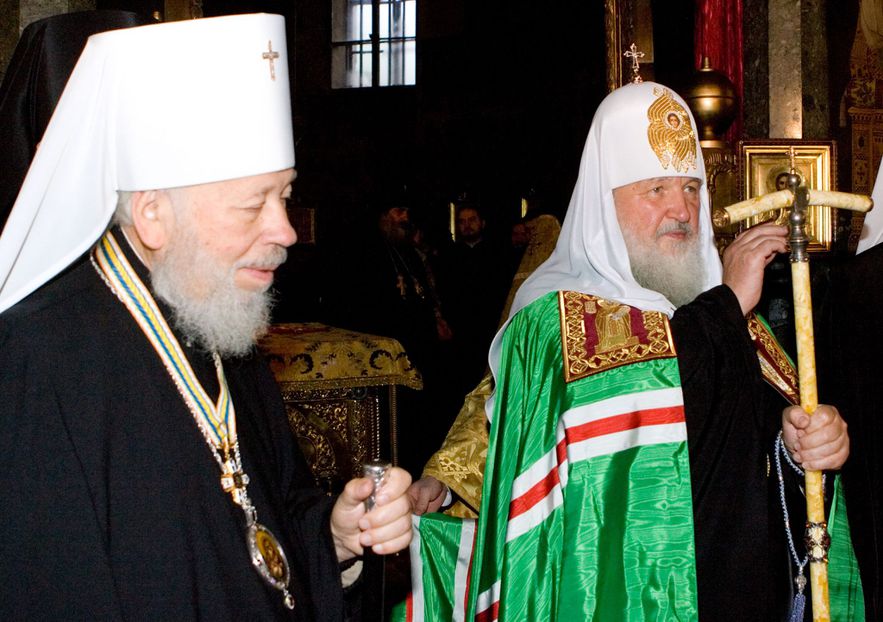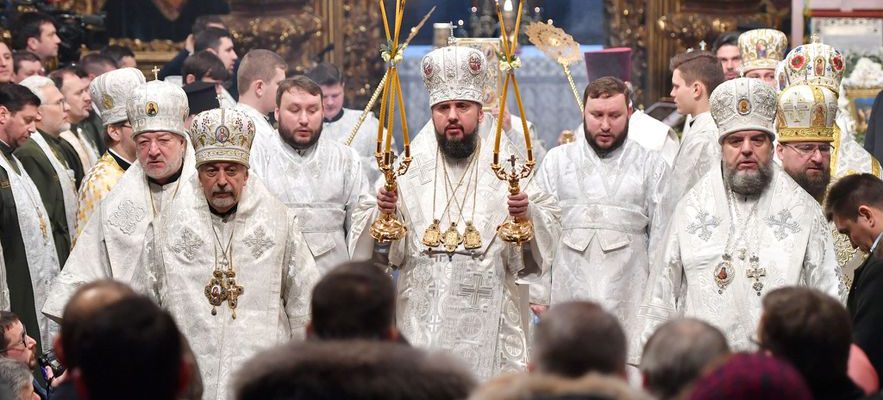One is in a purple cassock with gilding. The other in camouflage. In a parish of Khmelnytskyi (central Ukraine), on April 2, a dispute broke out between Arthur Ananiev, a soldier who tried to interrupt the mass, and a priest attached to the Moscow Patriarchate, one of the two Orthodox clergy Ukrainians. “How many people still have to die for you to stop following the Russian patriarchy?”, he shouts to the parishioners, before being violently overpowered by the priests. Far from being anecdotal, this fight illustrates the war raging in Ukraine between the two branches of Orthodox Christianity. Far from the battlefields, religion is another field where the fracture between kyiv and Moscow is expressed, upsetting balances almost thousands of years old.
At first sight, it is difficult to make a distinction between the two dogmas. The faithful do not have a membership card. The rituals are the same. Even their name is almost identical. On the one hand, the Ukrainian Orthodox Church, affiliated with the Moscow Patriarchate, which recovered most of the Ukrainian religious buildings after the fall of the USSR. On the other, the Orthodox Church of Ukraine, autocephaly which has grown in importance since its creation in 2018, until seeing its autonomy validated by the Ecumenical Patriarchate of Constantinople.
“For a long time, this subject was not crucial for the faithful, analyzes Catherine Wanner, professor at the State University of Pennsylvania, specialist in religion in Ukraine. But since the beginning of the war, choosing one’s religious affiliation is become a means for civilians to show their support for the Ukrainian state and to express a political position.” If, before 2014, the Orthodox defined themselves above all in the polls as “only Orthodox”, today most have chosen their side. In 2020, only 1 in 3 believers identified with the Ukrainian Orthodox Church (attached to Kyiv), a proportion that rose to 1 in 2 after the invasion. Conversely, only 4% of believers say they follow the Moscow Patriarchate after February 24, 2022, four times less than in 2020.
First liturgy of the new Ukrainian Orthodox Church independent of Russian religious supervision, in Saint Sophia Cathedral in kyiv, January 7, 2019
© / afp.com/Sergei SUPINSKY
Continuing ties with Moscow
Similarly, after the Russian invasion, more than 700 parishes, previously attached to Russia, pledged allegiance to the Church of kyiv. In 2019, it had only 5,100 establishments. It lists 8,000 today.
Under pressure from the faithful, but also from political power and its own priests, the Church attached to the Moscow Patriarchate had to clarify its links with it. Especially since in Moscow, the patriarch Kirill, reputed to be close to Putin, appears as an ardent supporter of the war, assuring that the Russian soldiers who died on the front will be “washed of all their sins”. The consequence ? In May 2022, following a council, the Ukrainian institution declared its “full independence” from the Moscow Patriarchate.
But in fact, it is far from having cut ties with Moscow, alert Lioudmila Filipovitch. “Where there was written ‘Moscow’ in the texts, they deleted the sentence, accuses this Ukrainian specialist in religious questions. But in the end, the affiliation is still there.” Thus, the metropolitan who heads this entity is always formally appointed by Moscow and subordinate to Patriarch Kirill, she specifies. And some Ukrainian clergy have retained positions in religious institutions in Russia.
“Behind these formal signs, the most worrying thing is that the historical, cultural, linguistic and personal ties remain with the Russian Orthodox Church”, deplores Lioudmila Filipovitch. Many members of this entity were educated in Russia in the 1990s and 2000s. In high places, many clerics hold Russian passports, like the Metropolitan Onuphre, at the head of the institution. Some even fled to the invader at the start of the invasion.

Metropolitan Volodymyr (L), head of the Ukrainian branch of the Russian Orthodox Church, with Patriarch Kirill on November 23, 2010 in kyiv
© / afp.com/Mykhaylo Markiv
And even if the accusations of collusion with Moscow date from before the war, the Ukrainian authorities only became interested in this file from November 2022, when the Ukrainian security service (SBU) changed direction. His agents then conducted searches of hundreds of places of worship, finding Russian passports, wads of cash and pro-Russian literature. About 60 criminal proceedings have been launched against members of this Orthodox branch and seven people have been convicted of collaboration.
On April 21, one of them was even exchanged for 28 Ukrainian prisoners. “We do not support war, these cases are exceptions, defends Vasiliy Makarovskiy, head of an association of parishioners close to this Orthodox Church historically linked to Russia. Look in the ranks of the security services, there were also collaborators…”
Nicknamed “Pavlo Mercedes”, the abbot of the monastery drives in a big engine
The latest development concerns kyiv’s Lavra of the Caves, a huge complex made up of dozens of medieval churches, nestled on a hill overlooking the Dnieper. Earlier this year, kyiv announced its intention to recover the property of Ukraine’s holiest monastery. Former pro-Russian President Viktor Yanukovych had, before being ousted by the Maidan revolution in 2014, granted the Moscow Patriarchate the right to use the building. If the 200 or so monks considered to be affiliated with Moscow refused to leave, clerics from the Independent Church of Kiev nevertheless celebrated Palm Sunday Mass there on April 9, a first. The faithful of the Moscow Patriarchate, demonstrating in front of the monastery, have for several days prevented the agents of the ministry from making an inventory. In short, the war of the popes is raging.
To drive the point home, the abbot of the monastery, whose taste for beautiful cars earned him the nickname “Pavlo Mercedes”, was placed under house arrest until the end of May. Ukrainian journalists revealed that he would spend these few weeks in his luxurious 600 square meter marble villa, built on illegally acquired land – a far cry from monastic asceticism. In addition, Father Pavlo is accused of incitement to religious hatred and approval of the Russian invasion.
Behind these antagonisms, the Ukrainian authorities are nonetheless torn between their duty to respect religious freedoms and their desire to marginalize a clergy whom they consider to be a Trojan horse of the Russian enemy. Not easy. Of Jewish and secular origin, Volodymyr Zelensky himself does not meddle in religious matters, unlike his predecessor Petro Poroshenko, a fervent supporter of an independent Ukrainian Church.
What can happen? A merger of the two persuasions seems unlikely, a ban on the Moscow Patriarchate, impossible. Ukrainian legislation does not allow the prohibition of a Church, split between hundreds of administrative entities. The Soviet period also shows that religious movements can survive underground. Judging the Church’s collaboration with Moscow can only be settled on a case-by-case basis. Before the court.
